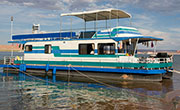
FRIDAY, July 4, 2014 (HealthDay News) — Houseboats that use gasoline-powered generators that lack emission controls may produce dangerous levels of carbon monoxide, a new safety study shows.
These generators don’t have a mechanism to reduce exposure to this dangerous, colorless and odorless gas. As a result, they regularly emit levels of carbon monoxide much higher than deemed safe by the U.S. National Institute of Occupational Safety and Health, according to the study. It was published online recently in the Journal of Occupational and Environmental Hygiene.
Boaters and marina workers should be cautious about their exposure to this potentially deadly gas, institute researchers cautioned.
“Houseboats that exhaust uncontrolled generator combustion gases beneath or near the rear deck indicated that extremely hazardous carbon monoxide concentrations can accumulate in that area,” Capt. Ronald Hall, of the division of applied research and technology in Cincinnati.
“These hazardous conditions were exacerbated when the drive engines were operating, placing employees who worked on or around the boats, as well as the boat operators, at risk,” Hall said in a journal news release.
In 2000, the U.S. Department of the Interior and the National Park Service asked the institute to examine the health hazards on and around houseboats. This request was made in response to carbon monoxide-related poisonings.
In conducting the study, the researchers analyzed carbon monoxide emissions on houseboats using exhaust emission analyzers, detector tubes, direct-reading carbon monoxide monitors and other sampling methods.
In response to their findings, the institute researchers worked with major houseboat and generator manufacturers to develop new ways to reduce carbon monoxide levels.
Between 2004 and 2005, low carbon monoxide emission marine generators were produced by the two largest manufacturers. These new generators reduced carbon monoxide concentrations on and around houseboats by up to 99 percent, the researchers said.
With the help of the U.S. Environmental Protection Agency, the institute also implemented regulations that apply to carbon monoxide emissions from generators, stern-drive engines, inboard and outboard engines and personal watercraft.
“Controlling exposures to occupational hazards is the fundamental method to protect workers,” said Hall. “Recommendations from this effort have enabled the marine industry to widely embrace innovative solutions to mitigate this hazard.”
More information
The U.S. Centers for Disease Control and Prevention provides more on carbon monoxide poisoning.
Copyright © 2025 HealthDay. All rights reserved.

